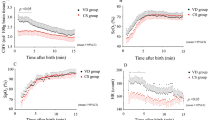Abstract
Background/Objective
Abnormal cerebral haemodynamics in very preterm infants undergoing neonatal intensive care have been associated with adverse outcome, but cerebral blood flow (CBF) is difficult to assess at the cotside. Spatially resolved spectroscopy (SRS) continuously measures cerebral tissue oxygen saturation expressed as tissue oxygenation index (TOI, %), and TOI would reflect changes in CBF with constant cerebral metabolic demand. We aimed to evaluate the relationship between simultaneous measurements of CBF (Transonic System) and TOI (Hamamatsu NIRO-200) in newborn lambs (n = 8). We hypothesised that alterations in CBF of different magnitudes and frequencies would be reflected as changes of TOI in both time domain and frequency domain analyses.
Methods
A silicon cuff positioned around the common brachiocephalic artery was inflated to induce 10–30% reductions in cerebral perfusion pressure so as to produce mild-to-moderate variations of CBF. Relationships between changes in CBF and TOI were evaluated in the time domain (Pearson correlation) and frequency domain (Coherence).
Results
In time domain analysis, there was significant correlation between ΔTOI (%) and ΔCBF (%) (R 2 = 0.69, P < 0.001). In frequency domain analysis, CBF-TOI coherence was ≥0.5 at frequencies below 0.1 Hz, but <0.5 at higher frequencies.
Conclusions
We conclude that overall TOI changes are concordant with CBF variations, when arterial oxygen saturation and cerebral oxygen consumption are constant. While TOI reflects CBF, it is more sensitive to variations of CBF of low frequency (<0.1 Hz) than to more rapid, higher frequency changes.




Similar content being viewed by others
References
Perlman JM, McMenamin JB, Volpe JJ (1983) Fluctuating cerebral blood-flow velocity in respiratory-distress syndrome. Relation to the development of intraventricular hemorrhage. N Engl J Med 309:204–209
Lassen NA (1959) Cerebral blood flow and oxygen consumption in man. Physiol Rev 39:183–238
Pryds O, Greisen G, Lou H, Friis-Hansen B (1989) Heterogeneity of cerebral vasoreactivity in preterm infants supported by mechanical ventilation. J Pediatr 115:638–645
Lou HC, Lassen NA, Friis-Hansen B (1979) Impaired autoregulation of cerebral blood flow in the distressed newborn infant. J Pediatr 94:118–121
Tsuji M, Saul JP, du Plessis A, Eichenwald E, Sobh J, Crocker R, Volpe JJ (2000) Cerebral intravascular oxygenation correlates with mean arterial pressure in critically ill premature infants. Pediatrics 106:625–632
Panerai RB (1998) Assessment of cerebral pressure autoregulation in humans–a review of measurement methods. Physiol Meas 19:305–338
Taylor GA, Short BL, Walker LK, Traystman RJ (1990) Intracranial blood flow: quantification with duplex Doppler and color Doppler flow US. Radiology 176:231–236
Matcher SJ, Kirkpatrick P, Nahid K, Cope M, Delpy D (1995) Absolute quantification methods in tissue near infrared spectroscopy. Proc SPIE 2389:486–489
TS SuzukiS, Ozaki T, Kobayashi Y (1999) A tissue oxygenation monitor using NIR spatially resolved spectroscopy. Proc SPIE 3597:582–592
Naulaers G, Morren G, Van Huffel S, Casaer P, Devlieger H (2002) Cerebral tissue oxygenation index in very premature infants. Arch Dis Child Fetal Neonatal Ed 87:F189–F192
An H, Lin W (2002) Cerebral venous and arterial blood volumes can be estimated separately in humans using magnetic resonance imaging. Magn Reson Med 48:583–588
Nagdyman N, Fleck T, Schubert S, Ewert P, Peters B, Lange PE, Abdul-Khaliq H (2005) Comparison between cerebral tissue oxygenation index measured by near-infrared spectroscopy and venous jugular bulb saturation in children. Intensive Care Med 31:846–850
Volpe JJ (2001) Intracranial hemorrhage: germinal matrix-intraventricular hemorrhage of the premature infant. In: Volpe JJ (ed) Neurology of the Newborn. WB Saunders, Philadephia, pp 428–448
Wong FY, Leung TS, Austin T, Wilkinson M, Meek JH, Wyatt JS, Walker AM (2008) Impaired autoregulation in preterm infants identified by using spatially resolved spectroscopy. Pediatrics 121:e604–e611
Grant DA, Franzini C, Wild J, Walker AM (1995) Continuous measurement of blood flow in the superior sagittal sinus of the lamb. Am J Physiol 269:R274–R279
Bland JM, Altman DG (1995) Calculating correlation coefficients with repeated observations: part 1–correlation within subjects. BMJ 310:446
Kuo TB, Chern CM, Sheng WY, Wong WJ, Hu HH (1998) Frequency domain analysis of cerebral blood flow velocity and its correlation with arterial blood pressure. J Cereb Blood Flow Metab 18:311–318
Stearns S, David R (1988) Signal Processing Algorithms. Prentice-Hall, Englewood Cliffs
Zhang R, Zuckerman JH, Giller CA, Levine BD (1998) Transfer function analysis of dynamic cerebral autoregulation in humans. Am J Physiol 274:H233–H241
Soul JS, Hammer PE, Tsuji M, Saul JP, Bassan H, Limperopoulos C, Disalvo DN, Moore M, Akins P, Ringer S, Volpe JJ, Trachtenberg F, du Plessis AJ (2007) Fluctuating pressure-passivity is common in the cerebral circulation of sick premature infants. Pediatr Res 61:467–473
Munro MJ, Walker AM, Barfield CP (2004) Hypotensive extremely low birth weight infants have reduced cerebral blood flow. Pediatrics 114:1591–1596
Jayasinghe D, Gill AB, Levene MI (2003) CBF reactivity in hypotensive and normotensive preterm infants. Pediatr Res 54:848–853
Jaeger M, Soehle M, Schuhmann MU, Winkler D, Meixensberger J (2005) Correlation of continuously monitored regional cerebral blood flow and brain tissue oxygen. Acta Neurochir (Wien) 147:51–56 discussion 56
Null RE, Reneau DD (1977) A computer analysis of graded ischemia in brain. Adv Exp Med Biol 94:219–224
Zhang R, Zuckerman JH, Iwasaki K, Wilson TE, Crandall CG, Levine BD (2002) Autonomic neural control of dynamic cerebral autoregulation in humans. Circulation 106:1814–1820
Edwards AD, Wyatt JS, Richardson C, Delpy DT, Cope M, Reynolds EO (1988) Cotside measurement of cerebral blood flow in ill newborn infants by near infrared spectroscopy. Lancet 2:770–771
Acknowledgments
This work was supported by National Health and Medical Research Council of Australia (project grant 384218).
Conflict of interest statement
The authors have no financial relationships relevant to this article to disclose.
Author information
Authors and Affiliations
Corresponding author
Rights and permissions
About this article
Cite this article
Wong, F.Y., Nakamura, M., Alexiou, T. et al. Tissue oxygenation index measured using spatially resolved spectroscopy correlates with changes in cerebral blood flow in newborn lambs. Intensive Care Med 35, 1464–1470 (2009). https://doi.org/10.1007/s00134-009-1486-4
Received:
Accepted:
Published:
Issue Date:
DOI: https://doi.org/10.1007/s00134-009-1486-4




